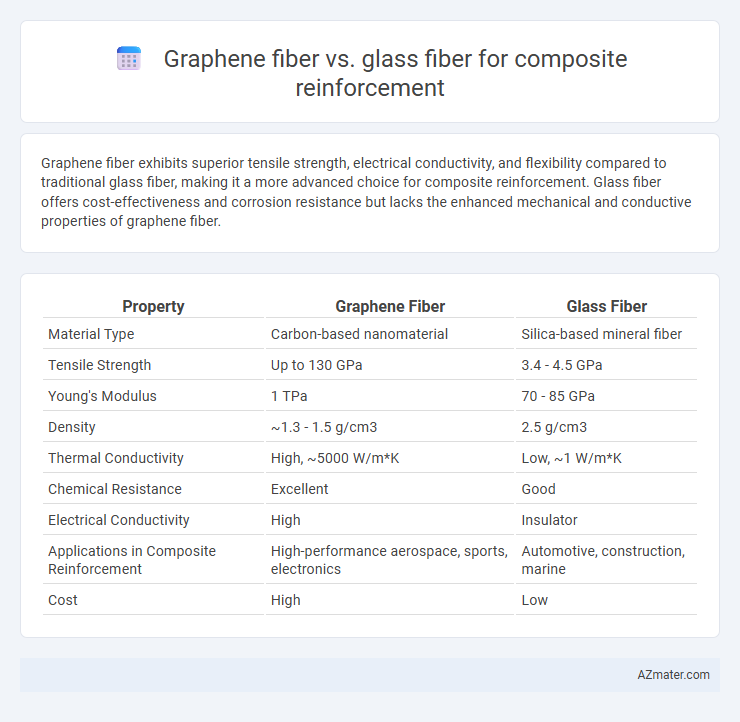Graphene fiber exhibits superior tensile strength, electrical conductivity, and flexibility compared to traditional glass fiber, making it a more advanced choice for composite reinforcement. Glass fiber offers cost-effectiveness and corrosion resistance but lacks the enhanced mechanical and conductive properties of graphene fiber.
Table of Comparison
| Property | Graphene Fiber | Glass Fiber |
|---|---|---|
| Material Type | Carbon-based nanomaterial | Silica-based mineral fiber |
| Tensile Strength | Up to 130 GPa | 3.4 - 4.5 GPa |
| Young's Modulus | 1 TPa | 70 - 85 GPa |
| Density | ~1.3 - 1.5 g/cm3 | 2.5 g/cm3 |
| Thermal Conductivity | High, ~5000 W/m*K | Low, ~1 W/m*K |
| Chemical Resistance | Excellent | Good |
| Electrical Conductivity | High | Insulator |
| Applications in Composite Reinforcement | High-performance aerospace, sports, electronics | Automotive, construction, marine |
| Cost | High | Low |
Introduction to Composite Reinforcement
Composite reinforcement enhances material strength by embedding fibers within a matrix to improve mechanical properties. Graphene fiber offers exceptional tensile strength, electrical conductivity, and lightweight characteristics, outperforming traditional glass fiber in stiffness and durability. Glass fiber remains widely used due to its cost-effectiveness, chemical resistance, and ease of fabrication despite lower tensile strength compared to advanced graphene fibers.
Overview of Graphene Fiber Properties
Graphene fiber exhibits exceptional tensile strength exceeding 3 GPa and a Young's modulus around 400 GPa, outperforming traditional glass fibers in mechanical performance. Its superior electrical conductivity and thermal stability make it highly suitable for advanced composite reinforcement, enabling multifunctional applications. Graphene fiber's lightweight nature combined with outstanding flexibility enhances composite durability while providing resistance to environmental degradation.
Overview of Glass Fiber Properties
Glass fiber exhibits high tensile strength, excellent thermal stability, and good chemical resistance, making it a widely used reinforcement material in composite applications. Its density is relatively low at around 2.5 g/cm3, providing a strong yet lightweight option compared to metals. The material also offers good electrical insulating properties and cost-effectiveness, contributing to its extensive use in automotive, aerospace, and construction industries.
Mechanical Strength Comparison
Graphene fiber exhibits significantly higher tensile strength and Young's modulus compared to glass fiber, making it superior for composite reinforcement in high-performance applications. The intrinsic strength of graphene fiber can reach up to 130 GPa, while glass fiber typically ranges between 2.5 and 4 GPa, indicating a substantial mechanical advantage. This enhanced strength improves the overall durability and load-bearing capacity of composites reinforced with graphene fibers.
Weight and Density Analysis
Graphene fiber exhibits a significantly lower density, approximately 1.3-1.5 g/cm3, compared to glass fiber's density of around 2.5 g/cm3, resulting in a lighter composite material. This reduced weight contributes to enhanced strength-to-weight ratios and improved performance in aerospace and automotive applications. The superior mechanical properties of graphene fiber allow for thinner and lighter reinforcements while maintaining or exceeding the stiffness and strength provided by traditional glass fiber composites.
Electrical and Thermal Conductivity Differences
Graphene fiber exhibits superior electrical conductivity, reaching values up to 10^6 S/m, compared to glass fiber's near-insulating properties with conductivity around 10^-12 S/m. Thermal conductivity of graphene fiber can exceed 5000 W/m*K, significantly outperforming glass fiber, which typically ranges between 1.0 and 1.4 W/m*K. These differences make graphene fiber highly advantageous for composite reinforcements requiring enhanced electrical and thermal management capabilities.
Durability and Environmental Resistance
Graphene fiber exhibits superior durability and environmental resistance compared to glass fiber, owing to its exceptional mechanical strength and chemical stability under extreme conditions. Its resistance to moisture, UV radiation, and thermal degradation enhances the longevity of composites in harsh environments. In contrast, glass fiber is prone to corrosion and weakening when exposed to alkaline or acidic conditions, reducing its overall lifespan in demanding applications.
Manufacturing Process and Scalability
Graphene fiber offers advanced mechanical properties and electrical conductivity, but its manufacturing process involves complex chemical vapor deposition or wet spinning techniques that limit large-scale production. Glass fiber, manufactured through continuous drawing of molten glass, benefits from established, cost-effective, and highly scalable processes, enabling mass production for composite reinforcement. Despite graphene's superior strength-to-weight ratio, glass fiber remains dominant in industrial applications due to its mature manufacturing infrastructure and availability.
Cost Efficiency and Market Availability
Graphene fiber offers superior mechanical strength and electrical conductivity compared to glass fiber, but its high production costs limit widespread market adoption. Glass fiber remains the cost-efficient choice for composite reinforcement due to its established manufacturing processes and extensive market availability. The affordability and scalability of glass fiber make it the dominant material in industries requiring large volumes of composite components.
Applications and Future Prospects
Graphene fiber exhibits superior mechanical strength, electrical conductivity, and flexibility compared to conventional glass fiber, making it ideal for advanced aerospace, automotive, and wearable tech composites. Glass fiber remains dominant in construction and marine applications due to cost-effectiveness and corrosion resistance, though it lacks the multifunctional capabilities of graphene fiber. Future prospects for graphene fiber include enhanced structural applications through multifunctional composites, nanotechnology integration, and large-scale manufacturing breakthroughs that could revolutionize industries focused on lightweight and high-performance materials.

Infographic: Graphene fiber vs Glass fiber for Composite reinforcement
 azmater.com
azmater.com